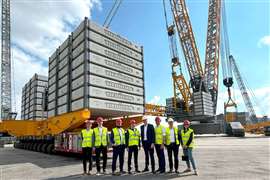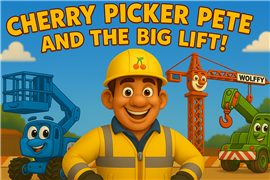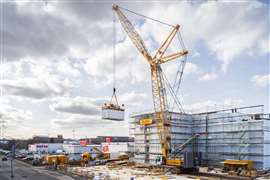A strong match
01 April 2017

Successful people tend to lead with their heads and their hearts. New Tadano America President Ingo Schiller is a good example of this type of leadership, combining an adept business acumen with a true passion for the people and the products in the crane industry.
Back at his Houston office after what he termed a “fantastic” ConExpo, Schiller is genuinely excited about his new role and reflective of the path ahead.
“The fortunate thing for me is that, in joining Tadano, I’ve stepped onto a train that is moving in the right direction and accelerating,” he said. “I’m benefitting from all that’s been done to get the Tadano products to this point and from the positive outlook for the market. My job is to make sure we have in place the people to expand our sales, service and parts, and to ultimately expand our customer base.”
To say the least, Schiller knows a lot about cranes, and fittingly, he has become enamored with Tadano cranes. He told me that he has “never experienced” what Tadano has accomplished in terms of product quality and customer satisfaction.
“The early approach Tadano has taken in North America was to establish its market foothold with a relatively small group of customers who then became very strong fans of the product,” he said. “These guys aren’t shy. They want to tell everyone how great Tadano products are.”
Like many crane industry veterans, Schiller grew up in the industry. His father, Heinz Schiller, has enjoyed a long and storied career in the crane business, starting in Germany in 1959. Heinz Schiller is credited with bringing some of the first all-terrain cranes to the United States, among many other accomplishments.
As a youngster, Schiller remembers walking the crane manufacturing halls with his father and sister, and when he was old enough, during school breaks and in the summer, he started working in the industry in which his father had introduced him. Shortly after finishing his engineering degree in 1992, he started working for a mobile crane OEM — just before Bauma in 1992. Since then he has worked in almost every area of crane manufacturing, from salesman to field service engineer to managing service, training and marketing departments to global product development, product management and business development, namely for Liebherr and Manitowoc. He agreed that his background bodes well for his new position with Tadano.
“I have shared in many of the experiences common to those in our industry. I have worked in the field, been employed, been the employer, started businesses, sold businesses, changed firms, been promoted to upper management and have also been layed off,” he said.
Schiller reveals his smarts and his heart when he talks about leading the team at Tadano. When he is not on the road visiting customers, he likes to sit at a desk in the service department in the Houston office.
“This allows me to hear the parts and service calls as well as see our service staff as they come and go to customer’s sites,” he said. “It is from the service department that I believe one maintains the closest connection to customers and their needs and challenges. It is from the service staff that we get the best understanding of the evolving needs of our customers.”
I’ve always found Ingo Schiller to be a straight shooter, easy to talk to and sincere. He’s a consummate learner and he seeks out and appreciates other veiwpoints. I think you will be interested in his answers to my questions.
What is it about the crane industry that has kept you engaged?
I enjoy the technical challenge, the evolving industry and most of all the people. The crane industry is special for several reasons; most people in the industry are optimists. They are always looking for opportunities and ways to make things better. The industry has a place for people of different skills and experiences, but it quickly pushes out those who are incompetent. This filtering is effective; anyone you meet who has been in the industry for even a few years is competent and effective in their area of operation. This industry has good people, great equipment, interesting jobs, technical challenges, fascinating locations and provides practical contributions to society.
What attracted you to Tadano America?
I was brought to this position by a few different paths. I had met Mr. Tadano several times at different industry events. I enjoyed his approach to business and appreciated his commitment to serving the industry with the highest quality products. The challenge of bringing these products to a broader array of customers in North America was a good match to my skill set and experience. I looked to speak with him when I traveled to the Bauma show in 2016.
My first day in Munich I encountered many people from the North American crane industry in the Old Town Center. Many of them told me that they thought that I would be a good fit with the Tadano team, including members of the Tadano America management team. These elements, combined with kind recommendations from some industry veterans, set the stage for me to join Tadano America at the end of August 2016.
You are the first president who is not a Tadano executive from Japan. Was this a strategic decision?
Yes, it was. Tadano has been active and successful in North America for almost 30 years. During that time there have been many Japanese expats that have worked here, building the business and facilitating communication between North America and Japan. Most of these expats are now working in key positions at Tadano in manufacturing, service and administration back in Japan providing support to Tadano America.
Mr. Tadano believed that now was the right time to put local management in North America to expand the offerings to a broader customer base. I am sure a large part of this decision was based on the success that Tadano has had with Alexander Knecht and his leadership at the factory in Germany and Tadano’s operations in Europe.
After your first few months, what are the positives? What are the challenges?
The two greatest positives are the products and the team that my predecessor, Yo Kakinuma, assembled over the last eight years. The challenge is to further scale up the operation to allow us to serve more customers and expand the customer base.
My primary responsibility at Tadano is to remove obstacles. I work to make it easy for customers to learn about Tadano cranes to make the right purchasing decisions for their business needs. I work to make it easy for the Tadano staff to meet the needs of our customers.
How do you characterize the crane market in 2017? 2018?
The conventional thinking is that 2017 will be similar to 2016 as far as industry demand, with the beginning of the upswing starting in 2018. We are already starting to see an increase in demand for our products. The confirmation of this upward trend started with customers’ response at ConExpo and their willingness to place orders at the show.
The challenges that our industry faced in the last few years have inspired an increasing sophistication in the customer base. The customers know more, are evaluating equipment more carefully, and their expectations of the equipment and the manufactures is increasing. All of these conditions bring improvement to the industry
I also see the industry evolving to a more data driven business environment. There is an ever increasing movement to more efficient operations with high utilization of owned assets. This is driving interest in equipment reliability, quick troubleshooting, fast spare parts supply, and total cost of ownership. All these things are becoming a larger part of the customer’s purchasing decision and therefore priorities for us.
Last year at Bauma Tadano introduced a prototype of an all-terrain crane with a triple boom system, the ATF-600G-8. What’s the status of this crane?
This crane brings immense lifting capabilities in a small footprint and using little airspace. At this point, the crane’s structure and load charts are fully tested. The work to be done is to finish the programing and testing of the control system. The AML-F control system was developed by Tadano and is currently installed and being used on other Tadano ATF model all terrain cranes.
This crane offers a new dynamic in boom systems and represents the first real change in boom design in many years. There’s also a huge safety advantage. No personnel will need to walk on the boom and no need for ladders for the super-lift installation. There is no boom suspension system, meaning there is no need for a super lift or Y-guy SSL. This means lower transportation costs, faster setup and fewer components, meaning fewer technical complications. The triple nesting of the jib pieces will reduce rigging time and trucking costs. The three-hoist drum means it will be ideal for tilt-up panel work and wind tower erection and maintenance. The first models are scheduled to ship mid-year 2018.
What was your take on ConExpo? Were your expectations met?
ConExpo was fantastic. This is my ninth ConExpo and the energy and enthusiasm of customers was better than anything that I have ever experienced. Current Tadano customers were generous with their time and engaged people who were new to Tadano cranes by telling them everything they should know about owning and working Tadano cranes. This made for a very welcoming environment for those starting their research on purchasing a Tadano crane. This adds confidence to a new buyer, knowing that current customers strongly promote the products.
This environment aided in our many sales at the show. We took orders from long-time owners and several orders from people new to the Tadano experience. We have grown our sales staff, and they are busy in the weeks after the show visiting customers and seeing what business needs we can fill with our products.
How many orders did you take?
I can’t say how many, but it was a significant number, especially for the new 120-ton RT, which sold very well. This crane got a big chunk [of orders] and the rest were spread out along the product lines, both RTs and ATs.
What crane in the Tadano product range are you most impressed with and why?
The GR-1000XL is the rough terrain crane that has grabbed my attention. The reasons for this are all of the stories customers tell me about the benefits and success that they have with this model. It is a delight that so many customers start conversations by telling me all of the things that they love about a crane.
In addition, I am impressed by the functionality of the Tadano Hello-net telematics system. This fully functional system has been operational for several years, and it is bringing a competitive advantage to our customers through fleet management and remote crane interaction. We are working with AEMP on developing the telemetric standards for cranes. Using this standard to transmit telemetric data will allow easy integration of data from different manufacturers into third-party monitoring systems. This will bring owners all the data on their crane fleets onto a single platform and allow owners to make better business decisions based on hard data such as utilization, crane performance, uptime, cost of operation and the like. We want to assist AEMP in their efforts so that the crane industry becomes better and more efficient through the use of performance data.
Taking this new job, learning the people and the products, and Then ConExpo – A very fast-paced few months. What do you do to wind down?
Time with my family is my favorite thing. When I am home, I spend time with my wife and follow my youngest son to his sporting events. I also enjoy the challenge and focus of flying small aircraft and maintaining my flight ratings.
When I am on the road, I work to find time to excercise, read and learn. I am a perpetual student.
I am finishing my Master’s Degree this May – on the same weekend and from the same university [George Mason University] from which our twin daughters will graduate.
STAY CONNECTED


Receive the information you need when you need it through our world-leading magazines, newsletters and daily briefings.
CONNECT WITH THE TEAM











